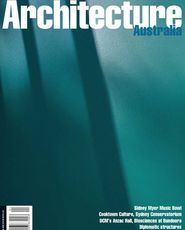As Christmas rolled by so too did the first anniversary of the new moral rights regime.
Unlike copyright, only individuals can hold moral rights. This means that an architectural partnership or company cannot exercise the moral rights of its partners, directors or employees. When a number of architects contribute to a project, if their contributions are divisible, each will hold moral rights in their divisible portion. If their creative contributions are indivisible then each will hold moral rights in the whole.
These and other aspects of the new regime fuel both conceptual debates (is architecture art?) and practical concerns. In the midst of these debates it is worth reflecting on what this first year has meant for the profession.
Although progress is slow, there is some evidence that the right of attribution will increase the recognition of the work done by architects and heighten the visibility of the profession. For example, the RAIA and the Advertising Federation of Australia have jointly issued a guideline for the advertising industry. This states that “where a visual, spoken or written reference to a work of architecture is integral to the purpose of an advertisement, in any media, the architect for the work is to be clearly identified”. The guideline definition of architectural work encompasses models, drawings, illustrations, buildings, groups of buildings, urban environments and furniture.
This strategy of using the new legislation as a platform for negotiations with peak bodies is probably the most effective way to achieve changes in industry practice. It is certainly more practical than relying on individual architects to agitate their claims.
Opinions differ as to the appropriateness of the balance struck in the legislation.
Architects concerned about protecting the integrity of their works may be disappointed by the breadth of defences available to those who allegedly infringe an architect’s right of integrity. On the other hand, Ashley Bell argues in the Property Law Bulletin that the right of integrity “dramatically limits the rights of building owners to alter or demolish their buildings”. But has the new right of integrity had any impact on the way architects and their clients do business?
Although a building owner is not compelled to consult with the original architect regarding proposed alterations to, or demolition of, a building, such consultation does ensure that the proponent will not infringe the architect’s right of integrity. One might expect this to lead to a rash of consultations. While there is little evidence of this, some consultations have occurred. The most high profile example involves Tonkin Zulaikha Greer’s proposed alterations to the National Gallery of Australia (NGA), and the ensuing consultations with the NGA’s architect Col Madigan.
Both critics and supporters of the new right of integrity could find something in the NGA process to support their perspective.
Critics could argue that the consultations have bogged down the project, resulting in negative publicity, delay and additional cost to the client. Supporters could argue that the consultations – which may never have occurred had Madigan not been able to rely on his right of integrity – have been extended beyond the statutory timeframe because of possible benefits to all parties.
The significance of this “flagship” consultation process extends beyond its impact on the NGA. The more constructive the process is perceived to be, and the more positive the outcomes, the greater the likelihood that at least some clients might refrain from requiring architects to sign away their right of integrity.
The Copyright Act does permit architects to consent to acts that infringe their moral rights. An increasingly dominant view among those who engage architects is that moral rights introduce both unnecessary delay and uncertainty: Exactly when do we have to attribute? What form of attribution is necessary? Who do we have to consult? (For example, does it include employee architects who contributed to the project?) What are “reasonable inquiries” regarding the identity and location of moral rights holders? The result is a growing belief that moral rights “consent” clauses should form a standard component of architects’ employment and consultancy contracts. Understandably, risk averse lawyers will generally advise their clients (whether they be public sector bodies, commercial developers or individual property owners) to include moral rights consent clauses in any contract with an architect.
Similarly, architectural firms will generally be advised to include comprehensive consent clauses in their contracts with employee architects. It is likely that one of the major impacts of the new moral rights regime will be the proliferation of these consent clauses.
Those architects who regard their entitlement to moral rights as an oddity illsuited to the nature of architectural practice will be sanguine about these developments.
Others, perhaps only a few, will have the bargaining power to retain their moral rights.
For the majority, however, signing away moral rights is likely to become the unwelcome price of doing business.
The Copyright Act does provide limited protection for those who wish to retain their moral rights. For example, a consultant architect can rely on the act to resist signing a completely open-ended and general consent (although an employee architect does not have the benefit of this provision) and any consent procured by duress or through false or misleading statements will be invalid (although making an architect’s engagement or employment conditional upon the signing of such a consent is unlikely to amount to duress).
Rather than relying on legal points, however, architects negotiating the retention of moral rights need to persuade the client of the mutual benefits involved. Possible strategies include minimising uncertainty regarding attribution by providing clear and reasonable guidelines on when and in what form attribution is appropriate. Architects should point out that attribution increases profile, and that increased profile adds value to the client’s project. As to the right of integrity, they should remind the client that early notice to the architect of the proposed works will avoid delays to construction (given that architects are provided a minimum of three weeks and a maximum of six weeks from the date of notice to consult with the proponent) and that this consultation effectively provides the proponent with an opportunity for a second, highly qualified opinion on the proposals at no cost. Finally, architects should try to point to examples where retaining the right of integrity has delivered benefits to both owner and architect. Given the generally positive reports regarding their value,the consultations on the NGA modifications may well provide architects with just such an example.
Jonathan Kenna is a intellectual property lawyer at the Canberra office of Deacons.
Moral rights: a summary
The Copyright Act provides architects with three moral rights:
- The right of attribution
- The right to prevent false attribution
- The right of integrity
Attribution
This entitles an architect to be attributed, in a clear and reasonably prominent way, as the creator of the building. The right arises only in certain circumstances, and there is room for debate about exactly what these circumstances are. However, in most situations an architect should be attributed if their building is the primary subject of a photograph published in hard copy or posted on the internet. The architect should also be acknowledged if the building forms more than an incidental part of a television broadcast or a film.
False attribution
The right to prevent false attribution is exactly that: the right to prevent someone falsely attributing you as the creator of a building. It is likely to be more relevant to well-known architects whose reputation might be “borrowed” to enhance the value and prestige of particular developments.
Integrity
This allows an architect to take action to prevent, or be compensated for, acts that are prejudicial to their honour or reputation. This includes the demolition or alteration of a building if it would be prejudicial in this way.
Defences
There are certain defences to alleged infringements of these rights. The right of attribution will not be infringed if it was reasonable, in all circumstances, not to identify the architect. Factors relevant in assessing reasonableness include industry practice and the difficulty or expense of identifying the architect. Similarly, the right of integrity will not be infringed if it was reasonable, in all circumstances, to subject the building to derogatory treatment. Again, in assessing reasonableness, factors such as industry practice are relevant. Importantly, the Copyright Act also makes it explicit that the relocation, demolition or alteration of a building will not infringe this right of integrity if, where contactable, the architect has been put on notice of the proposal and been given an opportunity (within six weeks of the date of notice) to either record the building or to consult with the owner about the proposals. Naturally, any act or omission within the scope of a valid consent given by an architect will not infringe moral rights. Given that only individuals hold moral rights, such consents must be obtained from individual moral rights holders rather than the corporate entity for which they work.
Source

Archive
Published online: 1 Jan 2002
Words:
Jonathan Kenna
Issue
Architecture Australia, January 2002














